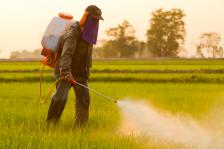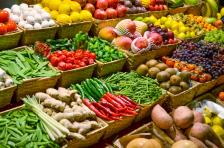How to Reduce Your Exposure to Pesticides
It’s a good idea to mimimize your exposure to pesticides. But you might be surprised to find out where they are (and aren’t) lurking.

I agree that it’s a good idea to minimize your exposure to pesticides. But I think many of us are focusing our pesticide-avoidance efforts in the wrong place.
Sponsor: Squarespace, the all-in-one platform that makes it fast and easy to create your own professional website, e-commerce site, or online portfolio. For a free trial and 10% off, go to squarespace.com/diva and use offer code DIVA
Pesticides Are Harmful to Health
There’s no question that pesticides can be harmful to humans and other life forms. Exposure to high levels of pesticides has been linked to an increased risk of cancer and other damage to tissues and organs. Pesticides (or the compounds they break down into) can also disrupt hormone function, affecting fertility, reproduction, growth, and development. We’ve already seen the effects of pesticides on other life forms – everything from honeybees to fish to frogs.
When it comes to pesticide exposure, what’s in your salad may actually be the least of your concerns.
That’s why Mom straps Junior into his organic hemp snuggli every Saturday morning and heads off to the farmer’s market to round up a week’s worth of organic produce and to make sure that free range chickens are eating only organic grubs. That’s why many of you have memorized the Environmental Working Group’s “Dirty Dozen” and “Clean 15” lists of the produce with the highest and lowest pesticide residues.
But when it comes to pesticide exposure, what’s in your reusable grocery bag may actually be the least of your concerns.
Are the “Dirty Dozen” Not so Dirty After All?
Carl Winter, a scientist at the University of California, Davis, recently pointed out that the amount of pesticides you’ be exposed to from eating Dirty Dozen fruits and vegetables is vanishingly small. Although it may be true that substituting organic versions of these 12 foods could reduce your exposure by up to 80%, this wouldn’t have any impact on your health or disease risk, because the amounts are so small to begin with.
Although I have mentioned the Dirty Dozen as a way of prioritizing your organic purchases, I’ve also tried to make it clear that eating fruits, vegetables, and other whole, minimally processed foods is far more important than making sure they are all organic.
See also: Putting Pesticide Concerns in Perspective

Hidden Sources of Pesticide Exposure
We also use pesticides and herbicides to kill bugs and weeds in our homes, yards, and gardens, parks, workplaces, schools, shopping malls, hospitals, grocery stores, and other public places. Although they are not being applied to our food, they still wash into our water supply and vaporize into the air we breathe. Pesticides also get into our bodies through our skin. Without even knowing it, most of us are constantly handling things that have been treated with pesticides, walking on surfaces that have been treated with them and tracking them into our houses.
While we can’t clean up the whole world, we can clean up our own backyards – and that would have an enormous impact.

One of the reasons that consumers use so many chemicals is that we don’t use them very carefully. We apply more than needed or use them more often than necessary. We use broad-spectrum chemical cocktails that promise to kill everything when a specific problem might be controled with a more conservative approach. We ignore safety measures and don’t take the time to dispose of containers properly.
Consumers use 10 times more pesticides per acre than farmers do.
So before you get out that weed killer this weekend, ask yourself if a few dandelions are really the end of the world. Investigate non-toxic methods of controlling pests. Consider turning some of your yard over to native plantings that require fewer chemicals to maintain. Here are some more ideas from the U.S. Fish and Wildlife Service on how to turn your garden into a chemical-free haven for the birds and the bees.
(In case you haven’t seen the news lately, our bees and pollinators could especially use a break!)
And if you absolutely must use chemicals to control pests – and as someone whose house is built on an anthill, I can certainly sympathize – be sure to use them exactly as indicated, or call in a professional who can advise you on how to get maximum control with the most conservative measures.
Then, sit back and enjoy your organic (or non-organic!) lunch, knowing that you’ve done something meaningful to reduce your pesticide exposure!
Farmer spraying pesticides image courtesy of Shutterstock.






